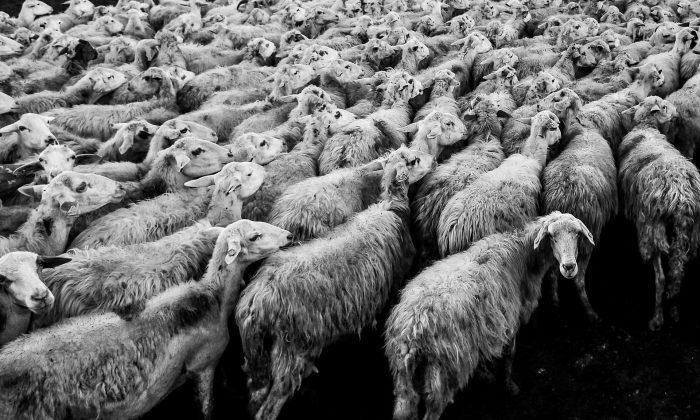Researchers from the Universities of Zaragoza and Navarra, Spain separated 21 male lambs into three groups. These received either common sheep vaccines, an aluminum ingredient called Alhydrogel used in many human as well as animal vaccines, or saline placebo. All other conditions were controlled. The researchers noted that the vaccinated and Alhydrogel animals became more solitary and anti-social than those injected with placebo. “In general, sheep are gregarious, and have a strong drive to be in the company of flock mates,” they said. Antisocial behavior is “uncommon and readily detected by an observer.” Fewer interactions with other animals “might indicate a deleterious effect on animal welfare,” the vets explained.
Restless, Repetitive Behavior
The Spanish vet researchers noticed that the vaccinated and aluminum-treated animals spent less time lying down than did the lambs in the control group. “The changes in the treatment groups reflect restless or excitatory behavior because resting patterns can be used to identify social stress in animal husbandry,” the study says. “Sheep exhibit a consistent and synchronous pattern of activity and resting, which the inoculations appeared to have altered.”“They also exhibited a significant increase in excitatory behavior and compulsive eating,” the study, led by Lluís Luján, a professor of veterinary pathology at the University of Zaragoza, concluded.
In general, the researchers reported, the uncommon behavior changes were more pronounced in the lambs that received the vaccines rather than those given the aluminum vaccine ingredient only, though both groups were clearly affected while the control group was not.
Stressed Lambs
Blood tests showed that cortisol levels in the vaccinated and aluminum treated sheep were elevated during winter when cortisol levels fell in control sheep. “Cortisol is a good indicator of stress in animals that are exposed to adverse situations,” the researchers noted. As well, white blood counts (WBC) of the vaccinated animals were significantly higher than those of both other groups—another indicator of stress. “In our study, conditions were not stressful, which suggests that the vaccination was responsible for the increase in the WBC in the Vaccine Group.”Aluminum-Loaded Granulomas
The researchers published a separate study on October 31, in the journal Autoimmunity Reviews, which looked at tissue samples of the sheep post mortem following the experiment.Microscopic examination revealed that the vaccinated and aluminum treated animals had numerous “granulomas”—lumpy, cheese-like nodules up to two centimeters in diameter under their skin and in lymph nodes far from the injection sites. These nodules were found to contain macrophages—a type of white blood cell that engulfs pathogens, loaded with tiny shards of the toxic metal aluminum. The jagged edges of the aluminum had pierced sacs inside some of the macrophages, spilling out and apparently, triggering programmed cell death responses in the surrounding tissue.
Granulomas, the researchers noted, were more lumpy and prevalent in the vaccinated animals and tended to be flatter in the aluminum-only treated animals. None of the placebo animals had these bodies under their skin.
Fatal Disease
The experiment was part of a research effort to understand a mysterious new disease that had decimated the Spanish sheep industry between 2008 and 2010 following a government-mandated bluetongue vaccine campaign.Professor Luján was approached by farmers at the time who were losing entire flocks to the disease. Animals were affected in two phases: in the first acute phase, only a few animals in a flock became nearly unresponsive with an acute meningoencephalitis, and a second chronic phase, sometimes months later and frequently triggered by an exposure to cold weather, affected up to 100 percent of flocks. The sheep became restless and anxious, then showed extreme weight loss and neurological damage. Eventually, all four limbs were paralyzed and they dropped to their front quarters, comatose, and died.
Ovine ASIA, as Luján’s team called it, is an animal version of Autoimmune/Inflammatory Syndrome Induced by Adjuvants (ASIA)—an immune system disease first clearly defined in humans in 2011. Immunologists, including leading Israeli immunologist Yehuda Shoenfeld, recognized that adjuvants—foreign substances in the human body including vaccine adjuvants designed to evoke a powerful immune response—can in some individuals hyper-stimulate the immune system into self-attack mode. Autoimmune diseases that are an expression of self attack can manifest as everything from atopic dermatitis and arthritis to severe nervous system disorders including Guillain Barre Syndrome and multiple sclerosis. These diseases now affect up to one in five Americans and are a growing global health concern.
Public health agencies have been aware of problems with aluminum adjuvants since at least 2002.
They focused on aluminum, with more than 1,100 papers documenting its neurotoxicity. Aluminum strongly provokes the immune system and sets off poorly understood chains of immune reaction. It is added to numerous human vaccines including those for hepatitis A, hepatitis B, diptheria-tetanus, meningitis, and HPV.
Childhood OCD and Anxiety Disorders
Yet anxiety and compulsive disorders like those seen in the Spanish sheep—and like autoimmune diseases—have increased in children dramatically in recent years without satisfactory explanation.Using health insurance claims data, pediatrics professor James Leckman and four other researchers found that significantly higher numbers of vaccinated children were found among those who were diagnosed with anorexia, OCD, anxiety disorder and ADHD as soon as three months after their vaccinations compared to controls.
The anxious, repetitive and aggressive behavior documented in this latest study of sheep experimentally may provide clues to the pathogenesis of neurological psychiatric disorders.
“In our opinion, all these behavioral changes exhibited by the Vaccine and Adjuvant only lambs in our study are of outmost importance, as they are the first scientific explanation of some of the previously observed behavioral changes in flocks affected by the chronic phase of ovine ASIA syndrome,” the researchers conclude. “Indeed, these changes can be undoubtedly detected by veterinarians and farmers in field conditions but they have never been scientifically linked to vaccination and/or Al inoculations.”
Until now. Why the researchers were unable to re-induce the full-blown ASIA syndrome they had previously described remains a partial mystery. “Ovine ASIA is a multifactorial process where vaccines (or other immune system stimulators) are necessary but many times not totally enough,” Prof. Luján explained. “Clearly, our animals showed behavioral changes similar to spontaneous occurring ASIA (clearly seen in the paper) but to get the full-blown clinical appearance you need some factor we did not have:”
Unlike in the field, all of the experimental animals were young and male and treated well under controlled conditions. “You need external factors, such as cold (a type of stress),” Luján explained, “and we did not have a cold winter that year.”
“Even in these unsuitable conditions that we could not control,” Luján added, “we clearly saw neurological affection, which is the key step. Imagine if you do this with adult sheep under stress in the field…”
And imagine, as clearly public health and oversight agencies have not, that similar pathological mechanisms may be occurring in vaccinated children.




